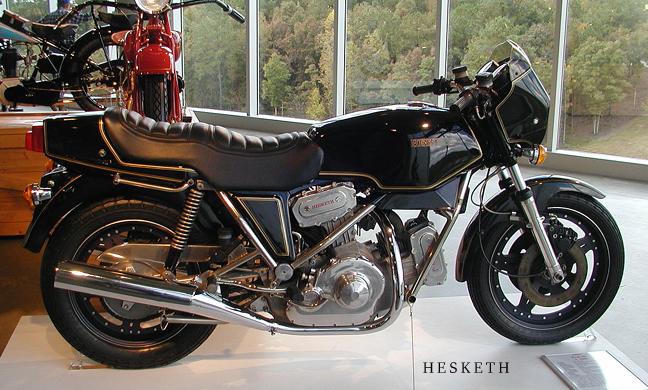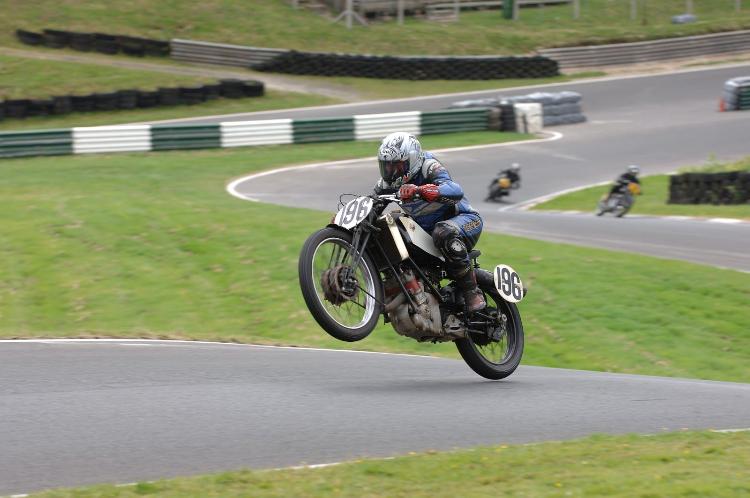Silk
|
Administrator
|
This post was updated on .
  Thanks again to Allred for a glimpse to what happened over the pond, back in the day. It was another of the doomed-to-failure projects of the 70s. George Silk thought it would be a good idea to utilize the two stroke engines from the antiquated Scott motorcycles in a "modern" bike, despite the fact that the Scott had hardly been a success even in its own time. Another of the period was the Hesketh, and there were pictures of a Weslake that didn't get any further than that, pictures. I guess there were people who thought they could succeed where the British motorcycle industry had failed. But somehow they not only failed to produce what the public wanted, they lacked the marketing, distribution, support, manufacturing capacity and finances, and to top it all the bikes were grossly overpriced and so didn't stand a chance of selling. The products ended up being novelty collector items. Not to belittle their efforts, but they didn't have a true grasp of the situation and the market, every young motorcycle enthusiast of the time could see the futility of their aspirations and knew it would all be for naught. |
|
Gonna have to switch one of those Hesketh pics for a SILK Grady.
|
|
Administrator
|
👍 |
|
Administrator
|
In reply to this post by grado
I’ve never heard of this bike. It does look like a brute.
A 700 two stroke?! I would like to hear that sucker hitting the pipe. . You meet some of the best folks behind bars. |
https://en.wikipedia.org/wiki/The_Scott_Motorcycle_Company Scotts motorcycles (the engines of which were used in the SILK) were around from the turn of the century. Scott Squirrels, Super Squirrels and Flying Squirrels were water-cooled two strokes of 500, 600 and even 1,000cc capacity and had some racing successes, specifically at the IOM TT. There were even 750 and 1,000cc water-cooled in-line 3-cylinder models but WWII prevented any real production, and post WWII the company was in financial trouble. Scotts went into liquidation and was rescued by Aerco Jig and Tool Company and thereafter known as the "Birmingham Scotts", which were relatively common in the 1950s and 1960s. I knew of a few in my town in the 1960s. The Scotts were of a innovative but idiosyncratic design at a time when 4 strokes ruled and so were probably way too ahead of their time, and when their time did arrive the Japanese did it better anyway. I assume George Silk saw the later Scott engines as a cheap and available asset. I can't help but wonder if there weren't some naive venture capitalists that got sucked in to both the Silk and Hesketh projects. . |
|
I just find it amazing, there was a brand that was running 2 stroke water cooled bikes 100 years ago. Running strong enough they were penalized, like today, cc wise, in racing events. I mean, when dirt bikes went wet, mid 1970s, it was like Japan were pioneers, landing on the moon or something. Water cooling, bike wise, was one of the biggest improvements in the last half century. Freakin Brits had already been there, done that! |
|
A buddy of mine, who had a Honda CB72 at the time (in the UK they were CB72 250cc not CB77 305cc making them available to young riders who were restricted to 250cc maximum) got all excited about a 500 Scott that was for sale locally, I told him he was crazy and to leave the thing well alone. I eventually talked him into buying a brand new 1969 Triumph Bonneville instead, he later agreed it was a much better decision!
|
Yeah I get what you're saying Allred. Talking to a few guys today, the conversations started with these bikes and drifted to a few different areas. One guy, a collector says he knows of 3 roadracers here in America. Always wanted one, but just can't justify the cost guys are wanting. They apparently are pretty rare over here. They are kinda weird, in a lot of ways. Engineering wise. I was told, if you were okay with a Suzuki Re5, the rotary thing, or a Wankel, you'd be good with a Scott. That racing wise, they kinda fell victim to the age old practice of promoters slanting the rules to the biggest manufacturers at the time. That they were always a small company, compared to a BSA of the 50s, and just could not mass produce enough to keep the prices in line with the likes of Norton and the others. Ya, good advice to your buddy on the Bonnieville. |
|
In reply to this post by motogrady
In all my reading of Kevin Cameron, somewhere he said that all the breakthroughs and advancements of our days can be found in the patents and engineering articles and production of the first era of motorcycling. They just didn't have the materials and electronics to realize them or support their operation. Aluminums, and valve spring steels and electronics for high rpm ignition and fuel injection. What I remember about the Scott, (which always intrigued me - a big fat two-stroke that needed Walter Kaaden's expansion chambers, had low, centralized CG, USD forks), was the cooling system was thermosiphon and inefficient for removing heat from the engine. If they had just invested in the complexity of a pump. But then there's that point about materials of the day. They must've wanted to stay away from a pressure system with strong hoses and good seals and a pump to leak and wear. Post-War money, materials and flush-customer shortage. Keep it simple, keep the factory going.
Choose to Ride.
Supports splitting everywhere.
|
«
Return to Cyclevisor.com
|
1 view|%1 views
| Free forum by Nabble | Edit this page |


